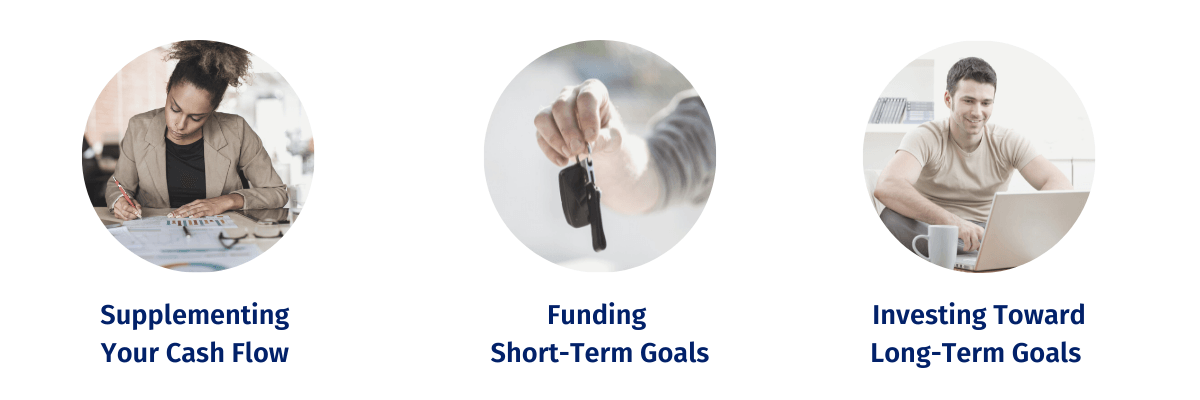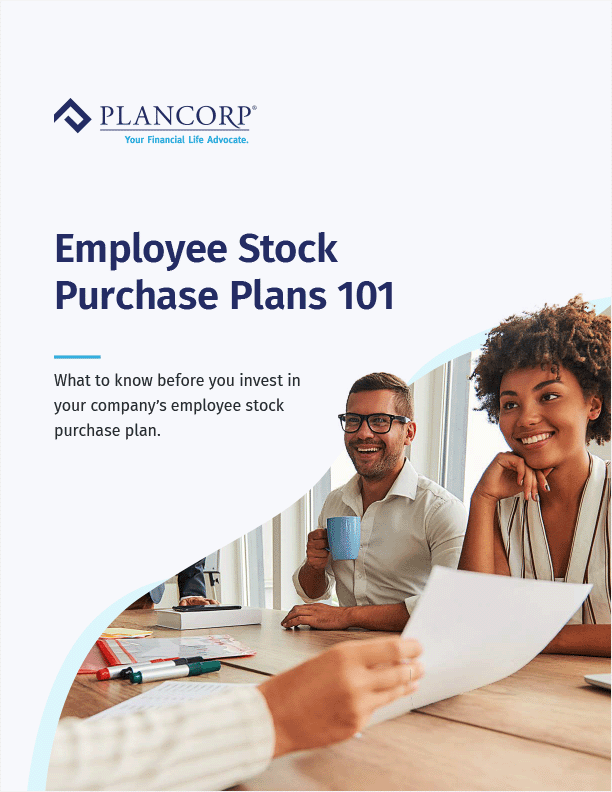Employee Stock Purchase Plans 101
Table of Contents
Still, with all of the different options and the many paths you can select when choosing your ESPP, you might not know what the best next step is for you. You will probably even have some questions about whether ESPPs are even worth it.
Below are ideas, information, and tips on what to do if you're offered an ESPP. Be sure to check out the ESPP calculator at the end, and use it to help you stay focused on either performance, tax or a combination of both.
Thanks for reading! Want the full guide in your inbox?
What is an Employee Stock Purchase Plan (ESPP)?
An employee stock purchase plan is a valuable benefit offered by some publicly traded companies. It allows employees to purchase company shares at a discount — often at 5%–15% of the fair market value and potentially more, depending on stock performance and how the ESPP is structured.
ESPPs are usually offered as an employment incentive and give employees the opportunity to share in the growth potential of the company. Contributions to a stock purchase plan are made through regular payroll deductions. After a specified period of time has passed — usually six months— accumulated cash is then used to buy company stock at a discount.
-1.png)
The company will keep the stock in the employee’s name until the employee decides to sell it. However, as with most company benefits, there are rules and limits to each ESPP, and we’ll dive into those more in detail below.
How Common Are ESPPs?
There isn’t a lot of research or data out there tracking how many companies employ the use of an ESPP, but independent research by Aon found that “49.0% of S&P 500 companies and 38.5% of Russell 3000 companies offer an ESPP to their employees.”
The research found that the industry with the highest prevalence of ESPPs was information technology, followed by healthcare and communication services. Here is a list of Fortune 100 companies that offer some sort of stock plan to employees, including ESPPs.
What are the Benefits of an ESPP?
The main benefit of having an ESPP is that you can purchase company stock up to 15% less than other investors. Stock acquired through ESPPs can be purchased with 1% to 15% of your salary, up to the $25,000 IRS limit per calendar year. And if you play your cards right, when you sell your stock, it’s like getting free money.
Another added benefit: Most ESPPs come with a lookback provision. This allows the discount to be applied to either the current stock price (as of the date of purchase) or to a historical stock price from a specified date in the past (the beginning of your offering period), usually 3-24 months ago — whichever is lower. If the current price of your company stock is higher than it was at the beginning of your offering period, then your actual discount to fair market value could far exceed 15%.
%20(1200%20%C3%97%20400%20px).png?width=750&name=Untitled%20(600%20%C3%97%20200%20px)%20(1200%20%C3%97%20400%20px).png)
You could also sell right away to lock in your profits from the discount and reinvest in a more diversified portfolio to fund intermediate- to long-term goals such as education and retirement. You may even decide that it makes sense to hang on to some or all of your newly acquired company stock to fund long-term goals.
Furthermore, no income tax is owed on the difference between your discounted purchase price and the fair market value of company stock on your date of purchase until the stock is sold. This gives you a great deal of flexibility to decide when it would be most advantageous to pay taxes, perhaps in a lower income tax year or once certain conditions have been met to receive long-term capital gain treatment on at least some of your profits.
With lots of moving pieces and potentially significant financial implications in play, the key to getting the most out of your ESPP is to make investment decisions within the context of a solid financial plan that is in line with your willingness and ability to take risks. You’ll also want to be sure you understand the tax implications of selling ESPP stock to avoid surprise tax bills and potentially costly mistakes.
How do Employee Stock Purchase Plans Work?

Entering an ESPP
First, there’s the enrollment period typically offered twice per year. Once enrolled, you get to decide how much money you’ll contribute, up to the maximum amounts allowed. Next, your company will open your personal ESPP account and cash contributions will be made on your behalf directly from each paycheck.

Purchasing an ESPP
Once you purchase stock through your company via an ESPP, it's yours until you decide to sell it. You can review some of the ways you can use ESPPs to achieve your personal finances here. It's important that you also understand that even if you quit your job, you will not lose your ESPP.
ESPP Offering Periods and Purchase Periods
ESPPs usually have 3- to 24-month offering periods. This is the period of time during which cash contributions are made to the plan via payroll deductions.

The first day of the offering period is known as the offering date. If longer than 6 months, the offering period is typically split up into multiple 6-month purchase periods where employees save into the plan via payroll deductions. At the end of each purchase period, on what is known as the purchase date, the cash contributed to the plan is used to purchase company stock on your behalf.
The first day of the offering period is known as the offering date. If longer than 6 months, the offering period is typically split up into multiple 6-month purchase periods where employees save into the plan via payroll deductions. At the end of each purchase period, on what is known as the purchase date, the cash contributed to the plan is used to purchase company stock on your behalf.
Qualified vs Non-Qualified for Employee Stock Purchase Plans
A qualified ESPP is designed and operates according to IRS 423 regulations, whereas a non-qualified ESPP does not. What this means for you is that there is more flexibility in how non-qualified plans can be designed. Qualified plans are treated more favorably with taxes. A non-qualified ESPP may look exactly like a qualified ESPP, but it won’t have the same tax advantages.
Know Your Options:
If you still don't feel comfortable determining if your stock is qualified or non-qualified, reach out to your advisor or contact someone from Plancorp today.
ESPP Contribution Limits
There are limits to how much you can contribute on a yearly basis. The Internal Revenue Service (IRS) currently sets a pre-discount upper limit of $25,000 per calendar year based on the stock price at the start of each offering period. So, for example, for ESPPs with a 10% discount, the most you can purchase each year is $22,500.
.png)
Companies also have the ability to further restrict contributions if they decide to do so. The cap varies by company but overall it usually ranges from 10% to 15% of your salary.
Instead of percentages, your company may set a share quantity or dollar amount limit on the contribution that is below the IRS’s limit.
Finally, note that the percentage of income you elect to contribute is based on your pre-tax salary, not your take-home pay. This is important to take into consideration for cash flow planning purposes because a contribution of 15% could actually reduce your take-home pay by substantially more than 15%. For example, say you make $100,000 per year. $40,000 of that goes to 401(k) contributions, health insurance and taxes, leaving you with a monthly take-home pay of $5,000. You decide to contribute 15% to your ESPP, which would be $1,250/mo. Your new take-home pay in this scenario would be $3,750, 25% less than what it was before.
The first step is to determine if selling your ESPP stock will result in a “qualifying disposition” or a “disqualifying disposition.”
A qualifying disposition occurs when you sell stock more than 24 months after the offering date and more than 12 months after the shares are purchased. If both conditions are met, then the amount of the discount you received (to be taxed as ordinary income) calculated as the lesser of:
- The fair market value of company stock on the offering date x the ESPP discount rate
- The sale price - the fair market value of stock on the offering date
Here are a few examples of this calculation with the following information being known:
- ESPP Discount: 15%
- Offering Data FMV: $100
- Purchase Date FMV: $125
- Purchase Price: $85 (calculated from $100 x .85)
Scenario 1: Sell at $140
ESPP Discount: 15%
X (times)
Offering Date FMV: $100
Total: $15
Sale Price: $140
– (minus)
Purchase Price: $85
Total: $55
Scenario 2: Sell at $90
ESPP Discount: 15%
X (times)
Offering Date FMV: $100
Total: $15
Sale Price: $90
– (minus)
Purchase Price: $85
Total: $5
Scenario 3: Sell at $80
ESPP Discount: 15%
X (times)
Offering Date FMV: $100
Total: $15
Sale Price: $80
– (minus)
Purchase Price: $85
Total: $-5
If the lower of the two numbers from Scenario 1 and 2 is negative, there is no ordinary income, only a capital loss.
If one or both of these conditions are unmet for Scenario 3, then the sale will be considered a disqualifying disposition. In this case, the amount included as ordinary income on your tax return is always equal to the FMV of stock on the purchase date minus the purchase price. In Scenario 3, this would mean that: Purchase Date FMV ($125) – Purchase Price ($85) = Ordinary Income ($40).
Stock sold at a price that is lower than the purchase date FMV does not decrease the amount of taxable ordinary income in a disqualifying disposition. Instead, you would receive a capital loss equal to the difference between the purchase date FMV and sale price.
Continuing with the Example
Still looking at the above example where the following information is known:
- ESPP Discount: 15%
- Offering Data FMV: $100
- Purchase Date FMV: $125
- Purchase Price: $85 (calculated from $100 x .85)
Purchase Date FMV ($125) – Purchase Price ($85) = Ordinary Income ($40)
Sale Price ($80) – Purchase Date FMV ($125) = Capital Gain/Loss (-$45)
This capital loss can be used to offset other capital gains in the current tax year and up to $3,000 of ordinary income, which means you may or may not be able to use the entire loss right away.
Determining How the Additional Gain or Loss of Your ESPP is Treated When It's Sold
If your ESPP stock is sold more than 12 months after the purchase date, any appreciation beyond the discount will be taxed as a long-term capital gain. Long-term capital gain tax rates are typically much lower than ordinary income tax rates, ranging from 0% to 20% federal, depending on your income.
If your ESPP stock is sold 12 months or less after the purchase date, any appreciation beyond the discount will be taxed as a short-term capital gain, subject to ordinary income tax rates ranging from 0% to 37% federal.
It is possible to receive long-term capital gain treatment in a disqualifying disposition if you sell ESPP stock more than 12 months after the purchase date but less than 18 months after the offering date. However, the amount of appreciation considered as a long-term capital gain will likely be less in a disqualifying disposition due to how the discount is calculated.
Regardless of how realized capital gains are characterized, it is important to note that you may also be subject to an additional 3.8% tax that applies to investment income above certain thresholds called the Net Investment Income Tax.
Selling ESPP stock after holding it for more than 18 months will often result in the most favorable tax treatment. However, it is important to remember that taxes should not be the only (or perhaps even primary) consideration in a decision to sell or hang onto shares of company stock. There are other factors at play including what the funds are being used for and how much company stock you currently own. Holding out for a qualifying disposition to save $1,000 in taxes would not be worth it if your ESPP shares lose $10,000 in value between now and then. This is especially important to consider when using your ESPP to fund short-term goals such as an emergency fund or a down payment on a home purchase.
Pro Tip
In most cases, holding your ESPP for at least 18 months, can result in the most favorable tax treatment compared to other timelines.
When and How to Sell Your ESPP Stock
Sticking with your employee stock purchase plan means you’ll have a large chunk of stock coming your way every six months or so.

Let’s say your ESPP allows you to purchase company stock every six months at a 15% discount based on the fair market value on the offering date (the beginning of the purchase period) or purchase date (the end of the purchase period), whichever is lower. You’re saving $10,000 into your ESPP every six months.
The stock price on the offering date is $117.65. Over the next six months, the price increases to $130 per share. On the purchase date, you buy $10,000 of company stock at $100 per share (15% discount off of the $117.65 offering date price, $10,000/$100 per share = 100 shares). You then immediately sell all of your shares at $130 per share for a total of $13,000. In this example, your pre-tax profit would be $3,000, which is an instant pre-tax return of 30% on your $10,000 investment. Not bad! This is one way you can use your ESPP to help cover current cash flow needs and fund short-term goals like establishing an emergency fund.
.png)
You may decide that you don’t want to sell your ESPP shares right away. As long as you are willing (and able) to accept this increased amount of risk, you don’t have an over-concentrated position in company stock relative to the rest of your portfolio, and you are using ESPP stock to fund a long-term goal such as retirement, this can be a great way to save for the future.It is important to note that taxes are not withheld when ESPP stock is sold. To avoid a surprise tax bill and potential penalties, you may need to increase tax withholding on wages and/or make estimated tax payments. The best way to plan for this is to complete a full tax projection at least once annually before the end of the current tax year, and potentially each time you sell company stock.
ESPP Calculator
An ESPP calculator estimates how much tax you'll pay plus your total return on an ESPP investment under three scenarios:
- Holding Period Not Met, Short Term Capital Gains
- Holding Period Not Met, Long Term Capital Gains
- Holding Period Met
We've created our own ESPP calculator to help make it easier for you to understand some of the content we just went over above. Click below to start your own calculations.
Next Steps
According to surveys completed by the National Association of Stock Plan Professionals, ESPPs are under utilized, and based on our experience that is because they aren't well-understood.
This missed opportunity is often due to a lack of experience investing in stocks, a low level of confidence in navigating the complexity of ESPPs, or high degrees of uncertainty around how to best manage and get the most out of the plan.
If you still have questions on whether an ESPP is right for you, this webinar covers everything from the role of company stock in your company to learning how to diversify your portfolio.
If you’re not sure whether you should use an ESPP instead of a 401(k), or if you’d like to use them in tandem, we can help. Click below to schedule free 15-minute consultation with one of our experts.
Download a PDF of this Guide

Enter your information below to receive a PDF copy of this Employee Stock Purchase Plans 101 guide.
Disclosure
This material has been prepared for informational purposes only and should not be used as investment, tax, legal or accounting advice. All investing involves risk. Past performance is no guarantee of future results. Diversification does not ensure a profit or guarantee against a loss. You should consult your own tax, legal and accounting advisors.
Disclosure
For informational purposes only; should not be used as investment tax, legal or accounting advice. Plancorp LLC is an SEC-registered investment adviser. Registration does not imply a certain level of skill or training nor does it imply endorsement by the SEC. All investing involves risk, including the loss of principal. Past performance does not guarantee future results. Plancorp's marketing material should not be construed by any existing or prospective client as a guarantee that they will experience a certain level of results if they engage our services, and may include lists or rankings published by magazines and other sources which are generally based exclusively on information prepared and submitted by the recognized advisor. Plancorp is a registered trademark of Plancorp LLC, registered in the U.S. Patent and Trademark Office.
Like What You’re Reading? Get Insights to Your Inbox. Unsubscribe Anytime.
Schedule a Call With a Wealth Manager to Get Started
Let Plancorp help so you can focus on making the most of your wealth
- Personal & Business Solutions
- Popular Resources
- Free Financial Analysis Tool
- Money Match Quiz
- Fee & Value Calculator
- Early Retirement Guide
- Equity Compensation Guide
- Estate Planning Guide
- Employee Stock Purchase Plan (ESPP) Guide
- Restricted Stock Units Guide
- Invest by Age Series
- Glossary of Financial Terms
- Client Guide
- What to Expect During an Advisor Transition
St. Louis, MO | Nashville, TN | Sarasota, FL | San Francisco, CA
Direct: 636-532-7824 | Toll Free: 888-220-1163 | info@plancorp.com
- Legal Notices
- Privacy Policy
- ADV Part 2A
- View Cefex Certificate
- Form CRS
- Press Room
- Cyber Security Policies
- © 2026 Plancorp, LLC.
© 2026 Plancorp, LLC. All Rights Reserved.



